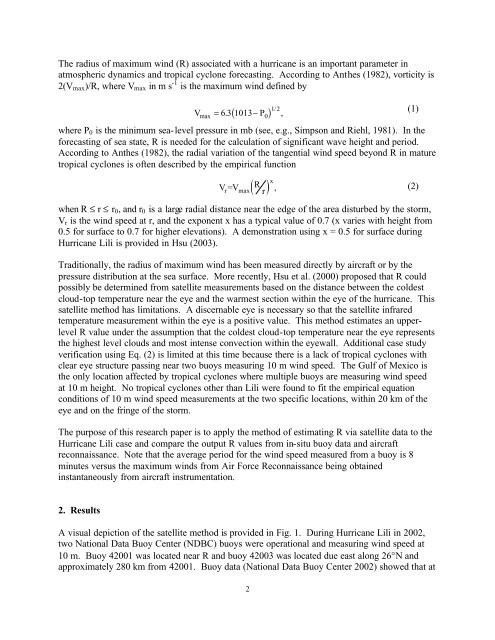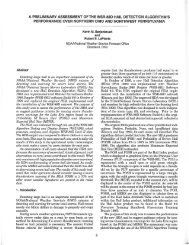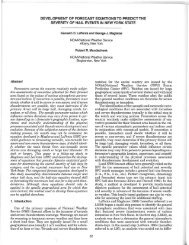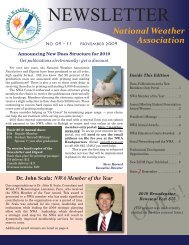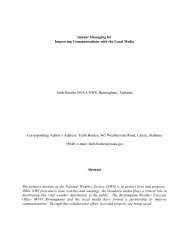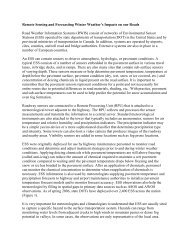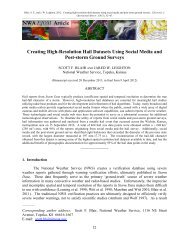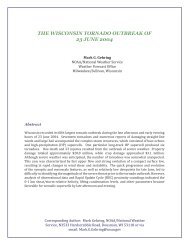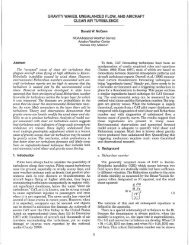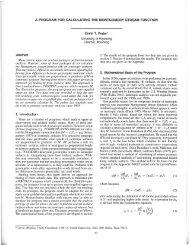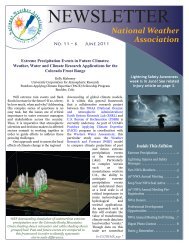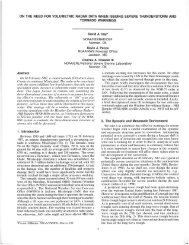ESTIMATING THE RADIUS OF MAXIMUM WINDS VIA SATELLITE ...
ESTIMATING THE RADIUS OF MAXIMUM WINDS VIA SATELLITE ...
ESTIMATING THE RADIUS OF MAXIMUM WINDS VIA SATELLITE ...
You also want an ePaper? Increase the reach of your titles
YUMPU automatically turns print PDFs into web optimized ePapers that Google loves.
The radius of maximum wind (R) associated with a hurricane is an important parameter in<br />
atmospheric dynamics and tropical cyclone forecasting. According to Anthes (1982), vorticity is<br />
2(V max )/R, where V max in m s -1 is the maximum wind defined by<br />
V<br />
max<br />
( P )<br />
1/<br />
2<br />
= 6. 3 1013−<br />
0 ,<br />
where P 0 is the minimum sea-level pressure in mb (see, e.g., Simpson and Riehl, 1981). In the<br />
forecasting of sea state, R is needed for the calculation of significant wave height and period.<br />
According to Anthes (1982), the radial variation of the tangential wind speed beyond R in mature<br />
tropical cyclones is often described by the empirical function<br />
V =V<br />
r<br />
( )<br />
x<br />
max ,<br />
when R ≤ r ≤ r 0 , and r 0 is a large radial distance near the edge of the area disturbed by the storm,<br />
V r is the wind speed at r, and the exponent x has a typical value of 0.7 (x varies with height from<br />
0.5 for surface to 0.7 for higher elevations). A demonstration using x = 0.5 for surface during<br />
Hurricane Lili is provided in Hsu (2003).<br />
Traditionally, the radius of maximum wind has been measured directly by aircraft or by the<br />
pressure distribution at the sea surface. More recently, Hsu et al. (2000) proposed that R could<br />
possibly be determined from satellite measurements based on the distance between the coldest<br />
cloud-top temperature near the eye and the warmest section within the eye of the hurricane. This<br />
satellite method has limitations. A discernable eye is necessary so that the satellite infrared<br />
temperature measurement within the eye is a positive value. This method estimates an upperlevel<br />
R value under the assumption that the coldest cloud-top temperature near the eye represents<br />
the highest level clouds and most intense convection within the eyewall. Additional case study<br />
verification using Eq. (2) is limited at this time because there is a lack of tropical cyclones with<br />
clear eye structure passing near two buoys measuring 10 m wind speed. The Gulf of Mexico is<br />
the only location affected by tropical cyclones where multiple buoys are measuring wind speed<br />
at 10 m height. No tropical cyclones other than Lili were found to fit the empirical equation<br />
conditions of 10 m wind speed measurements at the two specific locations, within 20 km of the<br />
eye and on the fringe of the storm.<br />
The purpose of this research paper is to apply the method of estimating R via satellite data to the<br />
Hurricane Lili case and compare the output R values from in-situ buoy data and aircraft<br />
reconnaissance. Note that the average period for the wind speed measured from a buoy is 8<br />
minutes versus the maximum winds from Air Force Reconnaissance being obtained<br />
instantaneously from aircraft instrumentation.<br />
R r<br />
(1)<br />
(2)<br />
2. Results<br />
A visual depiction of the satellite method is provided in Fig. 1. During Hurricane Lili in 2002,<br />
two National Data Buoy Center (NDBC) buoys were operational and measuring wind speed at<br />
10 m. Buoy 42001 was located near R and buoy 42003 was located due east along 26°N and<br />
approximately 280 km from 42001. Buoy data (National Data Buoy Center 2002) showed that at<br />
2


